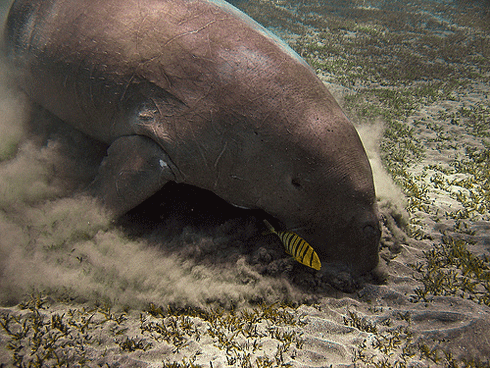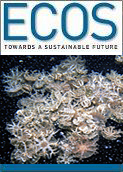
|
Published: 10 September 2012
‘Lady of the Sea’ under threat
Recent aerial survey estimates indicate a dramatic decline in dugong numbers on the Great Barrier Reef. Loss of seagrass feeding grounds is the most likely cause say scientists from James Cook University.

|
|
Dugongs are listed as vulnerable and endangered on the IUCN's ‘Red List’. A recent aerial survey suggests a dramatic decline in numbers on the southern Great Barrier Reef. Credit: Earthrace Conservation. Licensed under a Creative Commons Attribution No Derivatives 2.0 Generic License
|
The latest aerial survey of dugong distribution and abundance, conducted by researchers from James Cook Univeristy (JCU), did not find any evidence of dugong calves in the southern Great Barrier Reef (GBR). The survey found that numbers of dugongs are the lowest since the mid 1980s, indicating a dramatic reduction in the endangered mammal’s population in the region.
Professor Helene Marsh of James Cook University has been studying dugong numbers as part of a project on marine wildlife management in the GBR World Heritage area. According to Prof. Marsh, severe weather along the Queensland coast in the summer of 2010/11 affected the GBR’s endangered dugong population. The results of the survey show a reduction in fertility in response to those extreme weather conditions. The weather also exacerbated a decline in the seagrass feeding grounds of the dugong over several years.
‘Although aerial survey estimates of dugong are underestimates, they track trends in the population. The recent survey report, estimates a total number of about 3000 dugongs in south-east Queensland’s Moreton and Hervey Bays, similar to the previous aerial survey figure in 2005,’ says Prof. Marsh.
‘However it was a different story in the southern GBR region where the estimated size of the dugong population – about 500 to 600 – was the lowest since surveys began in 1986.
‘Similarly, while the proportion of dugong calves in Hervey and Morton Bays was within the range expected for normal conditions, no calves were seen in the southern GBR during the 2011 survey.’
Prof. Marsh said dugong mortalities recorded by StrandNet (the Queensland Marine Wildlife Mortality Database) in 2011 were the highest ever recorded.
‘The data indicates that Townsville and Gladstone were the dugong mortality “hotspots”,’ says Prof. Marsh. In both these places seagrass was in poor condition.
A report produced as part of the study into marine wildlife management in the GBR World Heritage area includes the following recommendations:
-
measures to protect dugongs along the coast, including increasing the proportion of protected dugong habitat in Moreton and Hervey bays to support their high density dugong populations
-
re-establishment of a regional Indigenous coordinating group to coordinate responses of Traditional Owners to extreme weather events in their Sea Country
-
the introduction of regional zoning of the East Coast Inshore Finfish Fishery to minimise interactions between fishers and dugongs.
The report also calls on the Queensland and Australian Governments to develop policy that favours the establishment of several well managed mega-ports along the GBR coast, which would pose fewer risks to dugongs and their habitats than a larger number of smaller ports.
Source: James Cook University



